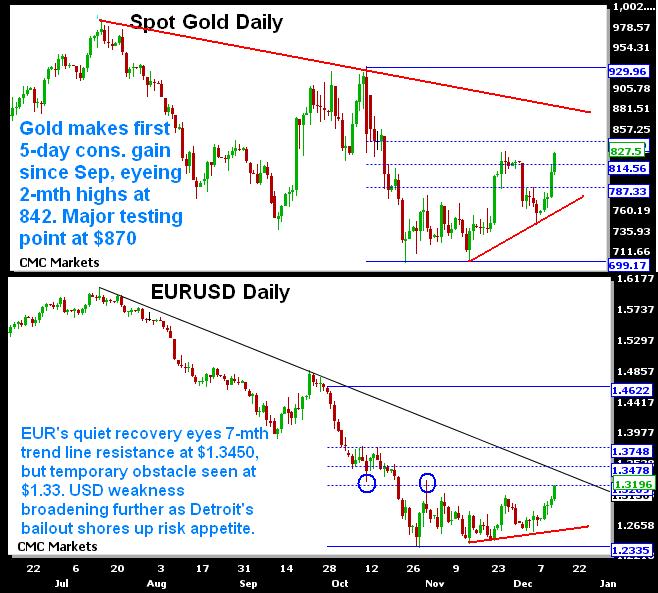U.S. Dollar in Retreat as Corporate Failure Risks Soar on U.S. Auto's Bailout
Currencies / US Dollar Dec 11, 2008 - 10:49 AM GMTBy: Ashraf_Laidi

 It may be premature to call the recent currency developments a paradigm shift, but it is worth shedding light on these changes as the news from Capitol Hill overlap with thin trading volumes. The current weakness of the US dollar is not only taking part against higher yielding counterparts such as the commodity currencies (which was usually assign of improved risk appetite), but also against the Japanese yen. Since the intensification of the market and economic weakness, the greenback would gain versus most major currencies with the exception of the yen during curtailed appetite, while losing ground versus its higher yielding counterparts and weighing on the yen at times of improved risk appetite.
It may be premature to call the recent currency developments a paradigm shift, but it is worth shedding light on these changes as the news from Capitol Hill overlap with thin trading volumes. The current weakness of the US dollar is not only taking part against higher yielding counterparts such as the commodity currencies (which was usually assign of improved risk appetite), but also against the Japanese yen. Since the intensification of the market and economic weakness, the greenback would gain versus most major currencies with the exception of the yen during curtailed appetite, while losing ground versus its higher yielding counterparts and weighing on the yen at times of improved risk appetite.
But the last 4 trading days are witnessing a gradual retreat in the US dollar, which is extending across USDJPY as US equity indices exhibit more valiant attempts of securing a bottom. With potentially market-punishing economic reports mainly out of the way for the year, the main focus remains on Capitol Hills final package for US automakers. This is clearly highlighted in USDJPYs inability to join EURJPY, GBPY and other yen crosses higher as it was customarily the case over the past year. The notion of broadening dollar weakness is explicitly reflected in golds rally past the $825 mark, which is the first 5-day winning streak since September. We have long argued that in order for gold to mount a more credible rally (beyond $850), downside US risks must be a stand-alone phenomenon (not joined by negative news in Europe and Asia).
The daily revelations of US automakers struggling foundation (having to settle for half their original $34 billion request) and the implications for their potential failure is raising transforming the risks into a US-specific risk, hence, bullish for gold. We have seen this during the failure of Lehman and the near failure of AIG. The implications for a "Failed Detroit" are enormous for the US economy as the auto sector is the biggest buyer of US steel, aluminium and even plastics and rubber. The industry employs over 240K direct and 5 million indirect workers and provides healthcare for 2 million employees. The auto industrys overall contribution to GDP is about 4%, with 12 billion annual spent on research and development.

Consequently, the dollar weakness is manifested across the board, even against the struggling GBP. But going back to EURUSD, the currencys quiet comeback is no longer latent as the $1.30 is breached and en-route towards $1.330. A breach above will encounter the next obstacle at the7-month trend line resistance of $1.3450, which could prove considerable for this week. Nonetheless, with the event risk of Fridays US retail sales and next weeks CPI, the $1.37 high target for the year remains viable. The trend line support of $1.28 becomes a backup foundation for $1.29.
EURGBP did the inevitable and broke to 0.8897. Oscillators suggest a temporary retreat is in the works near 0.8940-50, which could take us down to 0.87 before a renewed recovery towards 0.9300.
EURJPY remains the least bullish of the major euro pairs as the yen imposes its will on reluctance to buy risk abundantly. The pairs contrasting developments with USDJPY bolsters the argument for higher gold. Technicals suggest further upside towards 123.80, followed by the 50-day moving average of 124.
USDCAD continues its downward course in line with the weeks CAD analysis as the combination of improved risk appetite and higher commodities removes obstacles from CAD bulls. The argument that this weeks bigger than expected 75-bp cut may not be succeeded by more easing for some time is also providing more long term solidity for the loonie. Todays break below $1.2520, marks the breach of a major 2-month trend line support (extending from the 1.0316 low), which could pave the way for 1.2230.
Ashraf's book "Currency Trading & Intermarket Analysis" is out in US and Canadian stores this week. Risk appetite across currency, equity and fixed income markets is discussed in detail in Chapter 5.
By Ashraf Laidi
CMC Markets NA
AshrafLaidi.com
Ashraf Laidi is the Chief FX Analyst at CMC Markets NA. This publication is intended to be used for information purposes only and does not constitute investment advice. CMC Markets (US) LLC is registered as a Futures Commission Merchant with the Commodity Futures Trading Commission and is a member of the National Futures Association.
Ashraf Laidi Archive |
© 2005-2022 http://www.MarketOracle.co.uk - The Market Oracle is a FREE Daily Financial Markets Analysis & Forecasting online publication.


